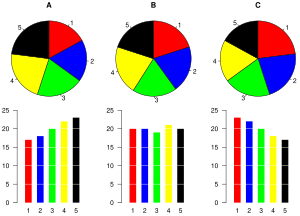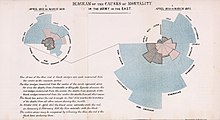The pie chart is perhaps the most ubiquitous statistical chart in the business world and the mass media.[3] However, it has been criticized,[4] and some recommend avoiding it[5][6][7], pointing out in particular that it is difficult to compare different sections of a given pie chart, or to compare data across different pie charts. Pie charts can be an effective way of displaying information in some cases, in particular if the intent is to compare the size of a slice with the whole pie, rather than comparing the slices among them.[1] Pie charts work particularly well when the slices represent 25 to 50% of the data,[8] but in general, other plots such as the bar chart or the dot plot, or non-graphical methods such as tables, may be more adapted for representing certain information.
Use, effectiveness and visual perception

Three sets of data plotted using pie charts and bar charts.
Further, in research performed at AT&T Bell Laboratories, it was shown that comparison by angle was less accurate than comparison by length. This can be illustrated with the diagram to the right, showing three pie charts, and, below each of them, the corresponding bar chart representing the same data. Most subjects have difficulty ordering the slices in the pie chart by size; when the bar chart is used the comparison is much easier.[9]. Similarly, comparisons between data sets are easier using the bar chart. However, if the goal is to compare a given category (a slice of the pie) with the total (the whole pie) in a single chart and the multiple is close to 25 or 50 percent, then a pie chart can often be more effective than a bar graph.
Variants and similar charts
Polar area pie chart
Florence Nightingale is credited with developing a form of the pie chart now known as the polar area diagram, though there are earlier uses. André-Michel Guerry invented the "rose diagram" form, used in an 1829 paper showing frequency of events for cyclic phenomena.[citation needed] Léon Lalanne later used a polar diagram to show the frequency of wind directions around compass points in 1843. The wind rose is still used by meteorologists. The polar area diagram is similar to a usual pie chart, except that the sectors are equal angles and differ rather in how far each sector extends from the center of the circle, enabling multiple comparisons on one diagram.Nightingale published her rose diagram in 1858. The name "coxcomb" is sometimes used erroneously. This was the name Nightingale used to refer to a book containing the diagrams rather than the diagrams themselves.[10] It has been suggested [by whom?] that most of Nightingale's early reputation was built on her ability to give clear and concise presentations of data.



No comments:
Post a Comment